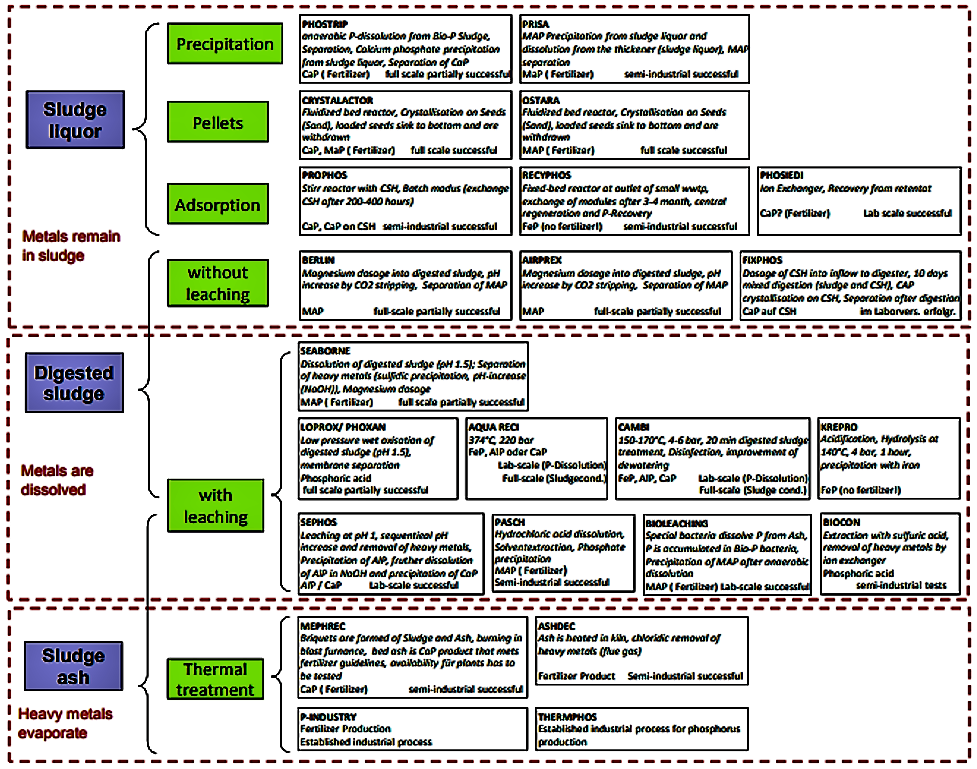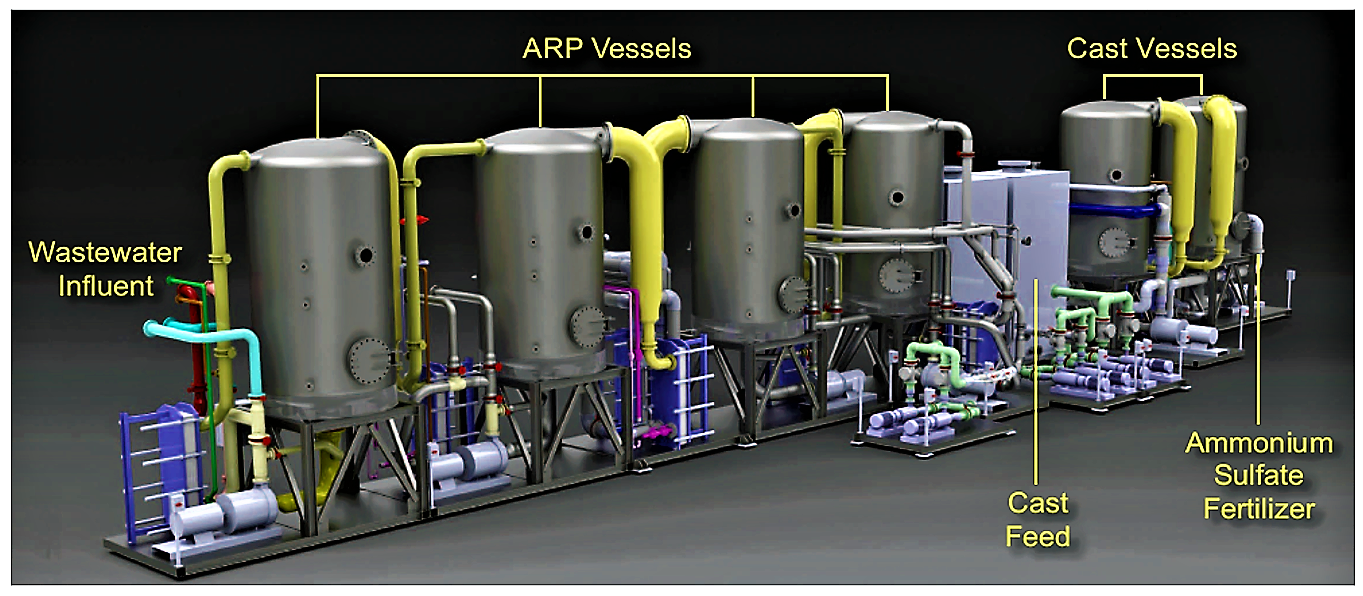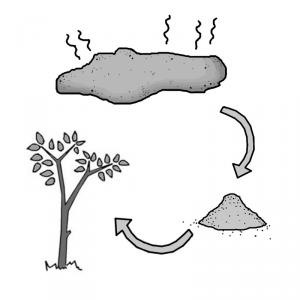Resumen ejecutivo
Wastewater, municipal sludge or the ash after dried sludge, which is incinerated or disposed of, can be a very rich source for nutrients, in particular phosphorus and nitrogen. There is a wide range of promising technologies emerging for modern agricultural systems, which strongly depend on phosphorus. Moreover, the emerging technologies that are expected to improve their effectiveness in the future separation of the different products (e.g. phosphorus rich toilet waste and urine from laundry water) will make the recovery of the nutrient resources even more efficient.
| Entradas | Salidas |
|---|---|
Fertiliser, Treated Water |
Phosphorus Recovery

Phosphorus (P) is a scarce natural resource (see peak phosphorus), vital for the health and growth of humans, animals, and all plants, in particular for agricultural crops (see also nutrient cycle. Unlike fossil fuels, other resources cannot replace phosphorus (TU DARMSTADT 2007).
SARTORIUS et al. (2011) distinguished 22 different P-recovery technologies, based on information from the internet and interviews. They are categorised by the origin of the waste (wastewater, sludge liquor, fermented or non-fermented sludge, ash) and the three major recovery processes.
Some of the described processes in the figure are still in development or only applicable at laboratory scale for the moment. The documents SARTORIUS et al. (2011) and NIEMINEN (2010) give a good overview on the different processes under development. The table below gives a list of documents which are particularly useful for specific processes.
| Process | Literature |
| AQUA RECI | STENMARK (2003): Supercritical Fluid Technologies within Chematur Engineering AB. |
| ASHDEC | Read the factsheet “Fertiliser from Sludge” |
| BIOCON | HULTMAN and LOEWEN (n.y.): Combined Phosphorus Removal and Recovery. LEVLIN (n.y.): Recovery of Phosphate from Sewage Sludge and Separation of Metals by Ion Exchange. |
| BIOLEACHING | ZIMMERMAN and DOTT (2009): Sequenced Bioleaching and Bioaccumulation of Phosphorus From Sludge Combustion – A New Way of Resource Reclaiming. |
| CAMBI | HULTMAN and LOEWEN (n.y.): Combined Phosphorus Removal and Recovery. |
| CRYSTALACTOR | DHV (2005): Phosphate Removal with a Crystalactor. |
| FIXPHOS | PETZET and CORNEL (2012): Prevention of Struvite Scaling in Digesters in Combination with Phosphorus Removal and Recovery - The FIX-Phos Process. |
| KREPRO | HULTMAN and LOEWEN (n.y.): Combined Phosphorus Removal and Recovery. |
| MEPHREC | NIEMINEN (2010): Phosphorus Recovery and Recycling from Municipal Wastewater Sludge. |
| OSTARA | Read the factsheet “Fertiliser from Sludge” |
| PASCH | NIEMINEN (2010): Phosphorus Recovery and Recycling from Municipal Wastewater Sludge. |
| PHOSIEDI | BMBF/BMU Funding Programme: Phosphorous Recovery Using Ion-Exchange and Electrodialysis (PHOSIEDI). |
| PHOSTRIP | KASCHKA &WEYRER (1999): Phostrip Handbook. MUTAG (n.y.): Multi Phostrip. |
| PRISA | MONTAG et al. (n.y.): A Feasible Approach of Integrating Phosphate Recovery as Struvite at Waste Water Treatment Plants. |
| PROPHOS | BMBF/BMU Funding Programme: Phosphorus Recovery from Wastewater, Sewage Sludge and Sewage Sludge Ashes (Prophos). |
| RECYPHOS | BMBF/BMU Funding Programme: Phosphorus Recycling - Sustainability Contribution at the Decentral Wastewater Treatment (RECYPHOS). |
| SEABORNE | MUELLER et al. (n.y.): Nutrient Recycling from Sewage Sludge Using the Seaborne Process. |
| SEPHOS | SCHAUM et al. (n.y.): Phosphorus Recovery from Sewage Sludge Ash – A Wet Chemical Approach. |
Nitrogen
Thermo ARP
Adapted from TNN (2011)
Based on CAST® technology platform, Thermo ARPTM combines heat and flash vacuum distillation for nitrogen removal. The system eliminates chemical pre-treatment and recovers nitrogen in the form of fertiliser that can be reused or sold. Thermo ARP is specifically designed for use with agricultural, industrial, and municipal anaerobic digesters where wastewater streams may require a simple treatment strategy for ammonia removal.
More techniques about nitrogen removal are described in MULDER (2003), e.g. with conventional nitrification or denitrification (see also activated sludge, vertical or horizontal wetlands). Ammonia stripping is also used to remove ammonia from wastewater (VRALE and JENSSEN 2005; EVANS n.y.). Further information can be found in the factsheets about struvite and urine diversion flush toilet, which facilitates nutrient recovery.

Cost Considerations/ Operation and Maintenance
All the described methods and processes are highly engineered and therefore expensive, and require expert knowledge and professional operators.
Some of these techniques are still not fully developed. Others are already in use in wastewater treatment plants around the world. As already mentioned, these technologies are expensive and require engineering knowledge to guarantee a sustainable and long-term operation of the facility.
Recovering Ammonium and Struvite Fertilisers from Digested Sludge Dewatering Liquors
This paper describes the results of investigating the potential for stripping N and P from dewatering liquors physico-chemically and the markets for the stripped N and P as fertilisers separate from the biosolids.
EVANS, T.D. (n.y): Recovering Ammonium and Struvite Fertilisers from Digested Sludge Dewatering Liquors. Stonecroft: Tim Evans Environment URL [Visita: 05.06.2012]Phosphorus Recovery and Recycling from Municipal Wastewater Sludge
The aim of this thesis is to discuss and overview the current methods for phosphorus recovery from municipal wastewater sludge, ash from sludge incineration, and the liquid phase after anaerobic treatment containing phosphorus in soluble form. The methods for recovery include crystallisation and precipitation, wet chemical methods, and thermo-chemical methods.
NIEMINEN, J. (2010): Phosphorus Recovery and Recycling from Municipal Wastewater Sludge. (= MSc Thesis ). Espoo: Aalto University, School of Science and Technology. [Accessed: 26.06.2012] PDFPhosphorus Recovery from Wastewater – State-of-the-Art and Future Potential
Today, there are already a variety of very different approaches to the recovery of phosphorus from wastewater, sludge and ashes. These approaches differ by the origin of the used matter (wastewater, sludge liquor, fermented or non-fermented sludge ash) and the process (precipitation, wet chemical extraction, and thermal treatment).
SARTORIUS, C. HORN, J. von TETTENBORN, F. (2011): Phosphorus Recovery from Wastewater – State-of-the-Art and Future Potential. Karlsruhe: Fraunhofer Institute for Systems and Innovation Research URL [Visita: 10.06.2019]ThermoEnergy ARP and Thermo ARP. Ammonia Recovery Process for Sidestream Treatment of Centrate, Filtrate, or Digestate Nitrogen
ThermoEnergyARP systems utilise a physical/chemical process that uses temperature and pressure separation to remove ammonia from water.
THERMOENERY (n.y): ThermoEnergy ARP and Thermo ARP. Ammonia Recovery Process for Sidestream Treatment of Centrate, Filtrate, or Digestate Nitrogen. Worcester: ThermoEnergy Corporation URL [Visita: 05.06.2012]Wastewater Treatment System Provides Nutrient Recovery
Why recycle phosphates
Source Separated Wastewater a New Resource for Producing Mineral Fertilizer
This presentation talks about separated wastewater as a new source for fertiliser production and includes 5 conventional options for concentration/solidification: 1. Membrane filtration; 2. Precipitation with iron and aluminium; 3. Precipitation and treatment with lime; 4. Struvite production; 5. Ammonia stripping in closed loop.
VRAALE, L. JENSSEN, P.D. (2005): Source Separated Wastewater a New Resource for Producing Mineral Fertilizer. Durban: 3rd. International Conference on Ecological Sanitation. [Accessed: 05.06.2012] PDFPhosphorus Recovery from Wastewater – State-of-the-Art and Future Potential
Today, there are already a variety of very different approaches to the recovery of phosphorus from wastewater, sludge and ashes. These approaches differ by the origin of the used matter (wastewater, sludge liquor, fermented or non-fermented sludge ash) and the process (precipitation, wet chemical extraction, and thermal treatment).
SARTORIUS, C. HORN, J. von TETTENBORN, F. (2011): Phosphorus Recovery from Wastewater – State-of-the-Art and Future Potential. Karlsruhe: Fraunhofer Institute for Systems and Innovation Research URL [Visita: 10.06.2019]Phosphorus Recovery and Recycling from Municipal Wastewater Sludge
The aim of this thesis is to discuss and overview the current methods for phosphorus recovery from municipal wastewater sludge, ash from sludge incineration, and the liquid phase after anaerobic treatment containing phosphorus in soluble form. The methods for recovery include crystallisation and precipitation, wet chemical methods, and thermo-chemical methods.
NIEMINEN, J. (2010): Phosphorus Recovery and Recycling from Municipal Wastewater Sludge. (= MSc Thesis ). Espoo: Aalto University, School of Science and Technology. [Accessed: 26.06.2012] PDFPhosphate Removal with a Crystalactor: Alto Dairy, Procorp Incorporated, USA
The Crystalactor® has been used for water softening, phosphorus removal and metal recovery in over 30 projects worldwide. Read more about it here.
DHV (2005): Phosphate Removal with a Crystalactor: Alto Dairy, Procorp Incorporated, USA. Amersfoort: DHV. [Accessed: 05.06.2012] PDFFaecal Sludge Management.
This issue presents studies from different regions (Bangladesh, Cameroon, Burkina Faso) that mainly show the non-existence of faecal sludge management. Additionally, the last paper describes a new technological solution (LaDePa) for producing hygienically safe organic fertiliser from sludge from ventilated improved pit toilets (VIPs).
ECOSAN CLUB (2012): Faecal Sludge Management.. (= Sustainable Sanitation Practice , 13 ). Vienna: Ecosan Club URL [Visita: 16.10.2012]Recovering Ammonium and Struvite Fertilisers from Digested Sludge Dewatering Liquors
This paper describes the results of investigating the potential for stripping N and P from dewatering liquors physico-chemically and the markets for the stripped N and P as fertilisers separate from the biosolids.
EVANS, T.D. (n.y): Recovering Ammonium and Struvite Fertilisers from Digested Sludge Dewatering Liquors. Stonecroft: Tim Evans Environment URL [Visita: 05.06.2012]Combined Phosphorus Removal and Recovery
The paper presents directions for a new system technology for municipal wastewater treatment, in order to consider both phosphorus removal and recovery.
HULTMAN, B. LOEWEN, M. (n.y): Combined Phosphorus Removal and Recovery. Stockholm: Royal Institute of Technology URL [Visita: 10.06.2019]Phostrip Handbook
This handbook presents a description of biological elimination of phosphorus from domestic sewage by applying the enhanced PHOSTRIP process.
KASCHKA, E. WEYRER, S. (1999): Phostrip Handbook. (= Fourth Edition ). Simbach: Phostrip Abwassertechnik GmbH URL [Visita: 26.06.2012]Recovery of Phosphate from Sewage Sludge and Separation of Metals by Ion Exchange
Use of ion exchange processes as in the BioCon-process, make it possible to recover the phosphate as phosphoric acid, which is produced from apatite ore, thus preserving the limited apatite resources and the resources, mainly sulphur, needed for producing phosphoric acid from apatite.
LEVLIN, E. (n.y): Recovery of Phosphate from Sewage Sludge and Separation of Metals by Ion Exchange. Stockholm: Royal Institute of Technology URL [Visita: 10.06.2019]A Feasible Approach of Integrating Phosphate Recovery as Struvite at Waste Water Treatment Plants
The PRISA process (Phosphorus Recovery by ISA) can be integrated into the sludge treatment of a municipal wastewater treatment plant (wwtp). Related to the phosphorus inflow load to the wwtp, the process enables a recovery up to 40%. The recovered phosphate can be used either in agriculture or can be sold to the phosphate industry. The process can provide a sustainable sludge management in the future.
MONTAG, D. GETHKE, K. PINNEKAMP, J. (n.y): A Feasible Approach of Integrating Phosphate Recovery as Struvite at Waste Water Treatment Plants. Aachen: RWTH Aachen University, Institute of Environmental Engineering URL [Visita: 26.06.2012]Nutrient Recycling from Sewage Sludge Using the Seaborne Process
In the Seaborne process, nutrients are separated from the sewage sludge and processed to a fertiliser containing no heavy metals or organic pollutants. The products of the Seaborne process, MAP and ammonium sulphate can be agriculturally reused.
MUELLER, J.A. GUENTHER, L. DICHTL, N. URBAN, I. WEICHGREBE, D. ROSENWINKEL, K.H. BAYERLE. N. (n.y): Nutrient Recycling from Sewage Sludge Using the Seaborne Process. Germany: PFI Consulting Engineers; Technical University of Braunschweig; Institute of Waste Quality and Waste Management; ASG Stadt Gifhorn URL [Visita: 26.06.2012]The Quest for Sustainable Nitrogen Removal Technologies
In this paper the sustainability of current available and future nitrogen removal systems has been investigated. For the assessment of the sustainability six indicators were used; sludge production; energy consumption, resource recovery; area requirement and N2O-emission. For the evaluation of the position of the individual nitrogen removal systems in the anthropogenic nitrogen cycle a broad outline for a life-cycle analysis has been presented.
MULDER, A . (2003): The Quest for Sustainable Nitrogen Removal Technologies. Entradas: Water Science and Technology: Volume 48 , 67–75. URL [Visita: 26.06.2012]Multi Phostrip
The PHOSTRIP process benefits from the biochemical potential of microorganisms, which are able to concentrate phosphorus in their biomass. In the sidestream a part of the return sludge will pass anaerobic milieu conditions. The biomass accumulates easily degradable organic matters and discharge phosphate into the water. Due to this reaction a side stream with high phosphate concentration can be conditioned with several process steps to separate phosphorus in an economical way.
MUTAG (n.y): Multi Phostrip. Biological Phosphorus Removal From Municipal Waste-Water In The Side Stream Process. Aue/Sachsen : Multi Umwelttechnologie AG. [Accessed: 26.06.2012] PDFPrevention of Struvite Scaling in Digesters in Combination with Phosphorus Removal and Recovery - The FIX-Phos Process
A new approach has been developed and patented that combines struvite prevention and phosphorus recovery.
PETZET, S. CORNEL, P. (2012): Prevention of Struvite Scaling in Digesters in Combination with Phosphorus Removal and Recovery - The FIX-Phos Process. Darmstadt: Technische Universität Darmstadt URL [Visita: 26.06.2012]Ammonia Recovery/ Ammonia Removal from Liquids and Gases
This technical document describes scrubbing systems for the removal of ammonia from waste gases.
RVT (2010): Ammonia Recovery/ Ammonia Removal from Liquids and Gases. Steinwiesen: RVT Process Equipment GmBH URL [Visita: 10.06.2019]Phosphorus Recovery from Sewage Sludge Ash – A Wet Chemical Approach
Sequential precipitation of phosphorus (SEPHOS Process) seems to be promising. The generated product, an “aluminium phosphate”, is a valuable raw material for the phosphorus industry. After alkaline treatment of the “aluminium phosphate”, it is possible to precipitate phosphorus as calcium phosphate (advanced SEPHOS Process). Following acidic elution of the ash, nano-filtration can also be used to separate phosphorus.
SCHAUM, C. CORNEL, P. NORBERT, J. (n.y): Phosphorus Recovery from Sewage Sludge Ash – A Wet Chemical Approach. Darmstadt/Essen: Technische Universität Darmstadt/Ruhrverband URL [Visita: 10.06.2019]Supercritical Fluid Technologies within Chematur Engineering AB
A description about the AquaReci (SCWO - Supercritical Water Oxidation) process.
STENMARK, L. (2003): Supercritical Fluid Technologies within Chematur Engineering AB. Karlskoga: Chematur Engineering AB URL [Visita: 26.06.2012]ThermoEnergy ARP and Thermo ARP. Ammonia Recovery Process for Sidestream Treatment of Centrate, Filtrate, or Digestate Nitrogen
ThermoEnergyARP systems utilise a physical/chemical process that uses temperature and pressure separation to remove ammonia from water.
THERMOENERY (n.y): ThermoEnergy ARP and Thermo ARP. Ammonia Recovery Process for Sidestream Treatment of Centrate, Filtrate, or Digestate Nitrogen. Worcester: ThermoEnergy Corporation URL [Visita: 05.06.2012]Sequenced Bioleaching and Bioaccumulation of Phosphorus From Sludge Combustion – A New Way of Resource Reclaiming
The recovery of phosphorus from sewage sludge incineration ash as well as the separation of heavy metals from ash was investigated by using the biotechnological process of bioleaching and bioaccumulation of released phosphorus by newly developed population of bioleaching bacteria.
ZIMMERMAN, J. ; DOTT, W. (2009): Sequenced Bioleaching and Bioaccumulation of Phosphorus From Sludge Combustion – A New Way of Resource Reclaiming. Entradas: Advanced Materials Research: Volume 71 URL [Visita: 05.06.2012]Opportunities in Fecal Sludge Management for Cities in Developing Countries: Experiences from the Philippines
In July 2012, a team from RTI International deployed to the Philippines to evaluate four FSM programs with the goal of reporting on best practices and lessons learned. The four cases—Dumaguete City, San Fernando City, Maynilad Water for the west zone of metro Manila, and Manila Water from the east zone of metro Manila—were chosen to highlight their different approaches to implementing FSM.
ROBBINS, D. STRANDE, L. DOCZI, J. (2012): Opportunities in Fecal Sludge Management for Cities in Developing Countries: Experiences from the Philippines. North Carolina: RTI International URL [Visita: 10.06.2019]Source Separated Wastewater a New Resource for Producing Mineral Fertilizer
This presentation talks about separated wastewater as a new source for fertiliser production and includes 5 conventional options for concentration/solidification: 1. Membrane filtration; 2. Precipitation with iron and aluminium; 3. Precipitation and treatment with lime; 4. Struvite production; 5. Ammonia stripping in closed loop.
VRAALE, L. JENSSEN, P.D. (2005): Source Separated Wastewater a New Resource for Producing Mineral Fertilizer. Durban: 3rd. International Conference on Ecological Sanitation. [Accessed: 05.06.2012] PDFhttp://www.phosphorrecycling.de/
The web page of BMBF/BMU initiative for circular economy for plant nutrients (especially phosphorous) provides additional information on ASH DEC projects. Further publications and up to date information are presented (in German).

